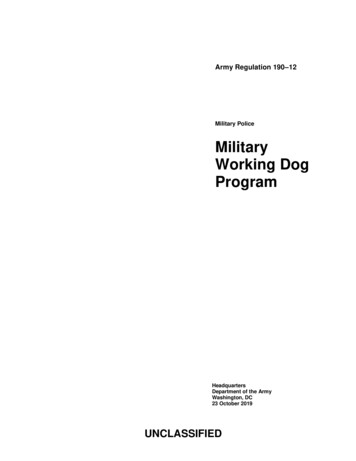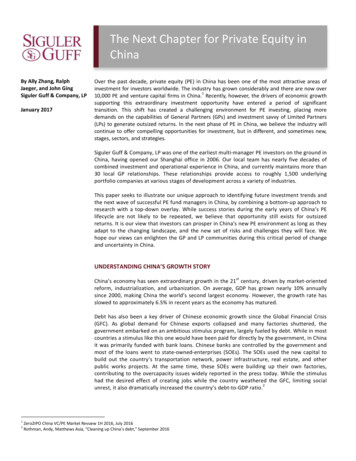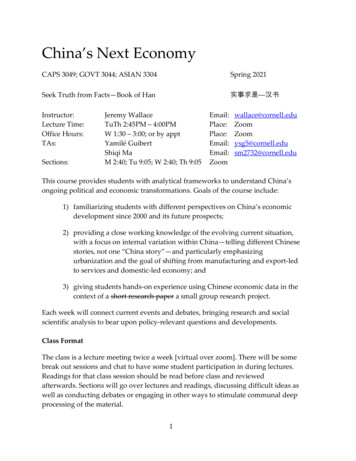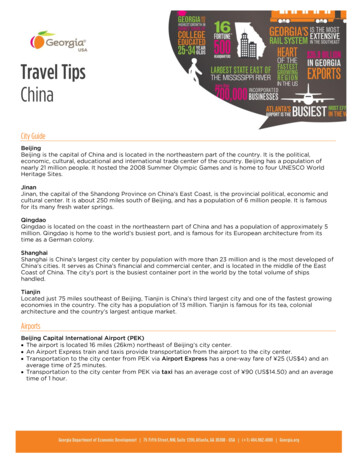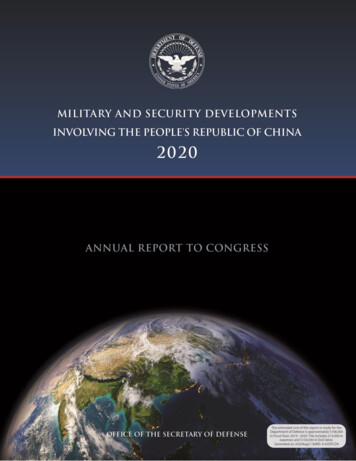
Transcription
OFFICE OF THE SECRETARY OF DEFENSEAnnual Report to Congress: Military and Security Developments Involving the People’s Republic of Chinai
OFFICE OF THE SECRETARY OF DEFENSEAnnual Report to Congress: Military and Security Developments Involving the People’s Republic of China
OFFICE OF THE SECRETARY OF DEFENSEAnnual Report to Congress: Military and Security Developments Involving the People’s Republic of ChinaMilitary and Security DevelopmentsInvolving the People’s Republic of China2020Annual Report to CongressA Report to Congress Pursuant to the National Defense Authorization Act forFiscal Year 2000, as AmendedSection 1260, “Modifications to Annual Report on Military and Security Developments Involving thePeople’s Republic of China,” of the National Defense Authorization Act for Fiscal Year 2020, PublicLaw 116-92, which amends the National Defense Authorization Act for Fiscal Year 2000, Section1202, Public Law 106-65, provides that the Secretary of Defense shall submit a report “in bothclassified and unclassified form, on military and security developments involving the People’s Republicof China. The report shall address the current and probable future course of military-technologicaldevelopment of the People’s Liberation Army and the tenets and probable development of Chinesesecurity strategy and military strategy, and of the military organizations and operational conceptssupporting such development over the next 20 years. The report shall also address United StatesChina engagement and cooperation on security matters during the period covered by the report,including through United States-China military-to-military contacts, and the United States strategy forsuch engagement and cooperation in the future.”
OFFICE OF THE SECRETARY OF DEFENSEAnnual Report to Congress: Military and Security Developments Involving the People’s Republic of ChinaPREFACE:A 20 YEAR RETROSPECTIVE ON CHINA’SSTRATEGY AND ARMED FORCES
OFFICE OF THE SECRETARY OF DEFENSEAnnual Report to Congress: Military and Security Developments Involving the People’s Republic of ChinaFor 20 years, the Department of Defense (DoD) has provided Congress with an annual report onmilitary and security developments involving the People’s Republic of China (PRC). These reportshave assessed the contours of China’s national strategy, its approach to security and military affairs,and potential changes in the PRC’s armed forces over the next 20 years, among other matters. 2020marks an important year for the People’s Liberation Army (PLA) as it works to achieve importantmodernization milestones ahead of the Chinese Communist Party’s (CCP) broader goal to transformChina into a “moderately prosperous society” by the CCP’s centenary in 2021. As the United Statescontinues to respond to the growing strategic challenges posed by the PRC, 2020 offers a uniqueopportunity to assess both the continuity and changes that have taken place in the PRC’s strategy andarmed forces over the past two decades.DoD’s first annual report to Congress in 2000 assessed the PRC’s armed forces at that time to be asizable but mostly archaic military that was poorly suited to the CCP’s long-term ambitions. The reportrecognized the CCP’s objective was for the PRC to become a “strong, modernized, unified, andwealthy nation.” Despite these great power aspirations, the PLA lacked the capabilities, organization,and readiness for modern warfare. Yet the CCP understood these deficiencies and set long-term goalsto strengthen and transform its armed forces in a manner commensurate with its aspirations tostrengthen and transform China.DoD’s 2000 report assessed that the PLA was slowly and unevenly adapting to the trends in modernwarfare. The PLA’s force structure and capabilities focused largely on waging large-scale land warfarealong China’s borders. The PLA’s ground, air, and naval forces were sizable but mostly obsolete. Itsconventional missiles were generally of short range and modest accuracy. The PLA’s emergent cybercapabilities were rudimentary; its use of information technology was well behind the curve; and itsnominal space capabilities were based on outdated technologies for the day. Further, China’s defenseindustry struggled to produce high-quality systems. Even if the PRC could produce or acquire modernweapons, the PLA lacked the joint organizations and training needed to field them effectively. Thereport assessed that the PLA’s organizational obstacles were severe enough that if left unaddressedthey would “inhibit the PLA’s maturation into a world-class military force.”Two decades later, the PLA’s objective is to become a “world-class” military by the end of 2049—agoal first announced by General Secretary Xi Jinping in 2017. Although the CCP has not defined whata “world-class” military means, within the context of the PRC’s national strategy it is likely that Beijingwill seek to develop a military by mid-century that is equal to—or in some cases superior to—the U.S.military, or that of any other great power that the PRC views as a threat. As this year’s report details,the PRC has marshalled the resources, technology, and political will over the past two decades tostrengthen and modernize the PLA in nearly every respect. Indeed, as this report shows, China isalready ahead of the United States in certain areas such as:i
OFFICE OF THE SECRETARY OF DEFENSEAnnual Report to Congress: Military and Security Developments Involving the People’s Republic of China Shipbuilding: The PRC has the largest navy in the world, with an overall battle force ofapproximately 350 ships and submarines including over 130 major surface combatants. Incomparison, the U.S. Navy’s battle force is approximately 293 ships as of early 2020. Land-based conventional ballistic and cruise missiles: The PRC has more than 1,250 groundlaunched ballistic missiles (GLBMs) and ground-launched cruise missiles (GLCMs) with rangesbetween 500 and 5,500 kilometers. The United States currently fields one type of conventionalGLBM with a range of 70 to 300 kilometers and no GLCMs. Integrated air defense systems: The PRC has one of the world’s largest forces of advanced longrange surface-to-air systems—including Russian-built S-400s, S-300s, and domestically producedsystems—that constitute part of its robust and redundant integrated air defense systemarchitecture.More striking than the PLA’s staggering amounts of new military hardware are the recent sweepingefforts taken by CCP leaders that include completely restructuring the PLA into a force better suitedfor joint operations, improving the PLA’s overall combat readiness, encouraging the PLA to embracenew operational concepts, and expanding the PRC’s overseas military footprint.Despite the PLA’s progress over the past 20 years, major gaps and shortcomings remain. The PRC’sleaders are aware of these problems, and their strategy envisions the PLA undergoing almost 30 moreyears of modernization and reform. Of course, the CCP does not intend for the PLA to be merely ashowpiece of China’s modernity or to keep it focused solely on regional threats. As this report shows,the CCP desires the PLA to become a practical instrument of its statecraft with an active role inadvancing the PRC’s foreign policy, particularly with respect to the PRC’s increasingly global interestsand its aims to revise aspects of the international order.Given the continuity in the PRC’s strategic objectives, the past 20 years offer a harbinger for the futurecourse of the PRC’s national strategy and military aspirations. Certainly, many factors will determinehow this course unfolds. What is certain is that the CCP has a strategic end state that it is workingtowards, which if achieved and its accompanying military modernization left unaddressed, will haveserious implications for U.S. national interests and the security of the international rules-based order.Report scope: This report covers security and military developments involving the PRC until the end of 2019.Developments in 2020, including the implications of the COVID-19 pandemic, will be covered in DoD’s 2021 report.ii
OFFICE OF THE SECRETARY OF DEFENSEAnnual Report to Congress: Military and Security Developments Involving the People’s Republic of ChinaThis page left intentionally blankiii
OFFICE OF THE SECRETARY OF DEFENSEAnnual Report to Congress: Military and Security Developments Involving the People’s Republic of ChinaEXECUTIVE SUMMARYiv
OFFICE OF THE SECRETARY OF DEFENSEAnnual Report to Congress: Military and Security Developments Involving the People’s Republic of ChinaUNDERSTANDING CHINA’S STRATEGYChina’s National Strategy The People’s Republic of China’s (PRC’s) strategy aims to achieve “the great rejuvenation of theChinese nation” by 2049. China’s strategy can be characterized as a determined pursuit of politicaland social modernity that includes far-ranging efforts to expand China’s national power, perfectits governance systems, and revise the international order. The Chinese Communist Party (CCP) frames this strategy as an effort to realize long-heldnationalist aspirations to “return” China to a position of strength, prosperity, and leadership onthe world stage. The CCP’s leadership has long viewed China as embroiled in a major international strategiccompetition with other states, including, and in particular, the United States. In 2019, China intensified its efforts to advance its overall development including steadying itseconomic growth, strengthening its armed forces, and taking a more active role in global affairs.Foreign Policy The PRC’s foreign policy seeks to revise aspects of the international order on the Party’s termsand in accordance with ideas and principles it views as essential to forging an external environmentconducive to China’s national rejuvenation. In 2019, the PRC recognized that its armed forces should take a more active role in advancing itsforeign policy, highlighting the increasingly global character that Beijing ascribes to its militarypower.Economic Policy The CCP prioritizes economic development as the “central task” and the force that drives China’smodernization across all areas, including its armed forces. China’s economic development supports its military modernization not only by providing themeans for larger defense budgets, but through deliberate Party-led initiatives such as OBOR andMade in China 2025, as well as the systemic benefits of China’s growing national industrial andtechnological base.Military-Civil Fusion (MCF) Development Strategy The PRC pursues its MCF Development Strategy to “fuse” its economic and social developmentstrategies with its security strategies to build an integrated national strategic system and capabilitiesin support of China’s national rejuvenation goals.v
OFFICE OF THE SECRETARY OF DEFENSEAnnual Report to Congress: Military and Security Developments Involving the People’s Republic of China MCF encompasses six interrelated efforts: (1) fusing the China’s defense industrial base and itscivilian technology and industrial base; (2) integrating and leveraging science and technologyinnovations across military and civilian sectors; (3) cultivating talent and blending military andcivilian expertise and knowledge; (4) building military requirements into civilian infrastructure andleveraging civilian construction for military purposes; (5) leveraging civilian service and logisticscapabilities for military purposes; and, (6) expanding and deepening China’s national defensemobilization system to include all relevant aspects of its society and economy for use incompetition and war. While MCF has broader purposes than acquiring foreign technology, in practice, MCF meansthere is not a clear line between the PRC’s civilian and military economies, raising due diligencecosts for U.S. and global entities that do not desire to contribute to the PRC’s militarymodernization.Defense Policy & Military Strategy The PRC has stated its defense policy aims to safeguard its sovereignty, security, and developmentinterests. China’s military strategy remains based on the concept of “active defense.” In 2019, the PLA remained primarily oriented towards longstanding regional threats whileemphasizing a greater global role for itself in accordance with China’s defense policy and militarystrategy. China’s leaders stress the imperative of meeting key military transformation markers set in 2020and 2035. These milestones seek to align the PLA’s transformation with China’s overall nationalmodernization so that by the end of 2049, China will field a “world-class” military. The CCP has not defined what it means by its ambition to have a “world-class” military. Withinthe context of China’s national strategy, however, it is likely that China will aim to develop amilitary by mid-century that is equal to—or in some cases superior to—the U.S. military, or thatof any other great power that China views as a threat to its sovereignty, security, and developmentinterests.MISSIONS, TASKS, & MODERNIZATION OF CHINA’S ARMED FORCES INTHE “NEW ERA” The PRC’s strategy includes advancing a comprehensive military modernization program that aimsto “basically” complete military modernization by 2035 and transform the PLA into a “worldclass” military by the end of 2049. The PLA’s evolving capabilities and concepts continue to strengthen the PRC’s ability to counteran intervention by an adversary in the Indo-Pacific region and project power globally.vi
OFFICE OF THE SECRETARY OF DEFENSEAnnual Report to Congress: Military and Security Developments Involving the People’s Republic of China In 2019, the PLA continued to make progress implementing major structural reforms, fieldingmodern indigenous systems, building readiness, and strengthening its competency to conduct jointoperations. China has already achieved parity with—or even exceeded—the United States in several militarymodernization areas, including:–Shipbuilding: The PRC has the largest navy in the world, with an overall battle force ofapproximately 350 ships and submarines including over 130 major surface combatants. Incomparison, the U.S. Navy’s battle force is approximately 293 ships as of early 2020. Chinais the top ship-producing nation in the world by tonnage and is increasing its shipbuildingcapacity and capability for all naval classes.–Land-based conventional ballistic and cruise missiles: The PRC has developed itsconventional missile forces unrestrained by any international agreements. The PRC has morethan 1,250 ground-launched ballistic missiles (GLBMs) and ground-launched cruise missiles(GLCMs) with ranges between 500 and 5,500 kilometers. The United States currently fieldsone type of conventional GLBM with a range of 70 to 300 kilometers and no GLCMs.–Integrated air defense systems: The PRC has one of the world’s largest forces of advancedlong-range surface-to-air systems—including Russian-built S-400s, S-300s, and domesticallyproduced systems—that constitute part of its robust and redundant integrated air defensesystem (IADS) architecture.Developments in the PLA’s Modernization and Reform The People’s Liberation Army Army (PLAA) is the largest standing ground force in the world.In 2019, the PLAA continued to transition into a modern, mobile, and lethal ground force byfielding upgraded combat systems and communications equipment and enhancing its ability toconduct and manage complex combined-arms and joint operations. The People’s Liberation Army Navy (PLAN)—the largest navy in the world—is anincreasingly modern and flexible force that has focused on replacing previous generations ofplatforms with limited capabilities in favor of larger, modern multi-role combatants. As of 2019,the PLAN is largely composed of modern multi-role platforms featuring advanced anti-ship, antiair, and anti-submarine weapons and sensors.–Naval Shipbuilding and Modernization: The PLAN remains engaged in a robustshipbuilding and modernization program that includes submarines, surface combatants,amphibious warfare ships, aircraft carriers, and auxiliary ships as well as developing andfielding advanced weapons, sensors, and command and control capabilities.vii
OFFICE OF THE SECRETARY OF DEFENSEAnnual Report to Congress: Military and Security Developments Involving the People’s Republic of China The People’s Liberation Army Air Force (PLAAF) and PLAN Aviation together constitutethe largest aviation forces in the region and the third largest in the world, with over 2,500 totalaircraft and approximately 2,000 combat aircraft. The PLAAF is rapidly catching up to Westernair forces across a broad range of capabilities and competencies. The People’s Liberation Army Rocket Force (PLARF) is responsible for the PRC’s strategicland-based nuclear and conventional missile forces. The PLARF develops and fields a wide varietyof conventional mobile ground-launched ballistic missiles and cruise missiles. The PRC isdeveloping new intercontinental ballistic missiles (ICBMs) that will significantly improve itsnuclear-capable missile forces. The number of warheads on the PRC’s land-based ICBMs capableof threatening the United States is expected to grow to roughly 200 in the next five years.– The PRC is expanding its inventory of the multi-role DF-26, a mobile, ground-launchedintermediate-range ballistic missile system capable of rapidly swapping conventional andnuclear warheads.– The PRC’s robust ground-based conventional missile forces compliment the growingsize and capabilities of its air- and sea-based precision strike capabilities. The PLA Strategic Support Force (SSF) is a theater command-level organization establishedto centralize the PLA’s strategic space, cyber, electronic, and psychological warfare missions andcapabilities. The SSF Network Systems Department is responsible for cyberwarfare, technicalreconnaissance, electronic warfare, and psychological warfare. Its current major target is theUnited States.–The PRC’s Space Enterprise. The PRC’s space enterprise continues to mature rapidly.Beijing has devoted significant resources to growing all aspects of its space program, frommilitary space applications to civil applications such as profit-generating launches,scientific endeavors, and space exploration.–The PLA has historically managed the PRC’s space program. The SSF Space SystemsDepartment is responsible for nearly all PLA space operations.–In 2019, the PRC described space as a “critical domain in international strategiccompetition” and stated the security of space provided strategic assurance to the country’snational and social development.Military Readiness: In recent years, CCP leaders have directed the PLA to improve its combatreadiness. This guidance is increasingly evident in the intensity of the PLA’s training and thecomplexity and scale of its exercises.viii
OFFICE OF THE SECRETARY OF DEFENSEAnnual Report to Congress: Military and Security Developments Involving the People’s Republic of ChinaCapabilities for Counter Intervention and Power Projection The PLA is developing capabilities to provide options for the PRC to dissuade, deter, or, ifordered, defeat third-party intervention during a large-scale, theater campaign such as a Taiwancontingency. The PLA’s anti-access/area-denial (A2/AD) capabilities are currently the most robust within theFirst Island Chain, although the PRC aims to strengthen its capabilities to reach farther into thePacific Ocean. The PRC also continues to increase its military capabilities to achieve regional and global securityobjectives beyond a Taiwan contingency. The PLA is developing the capabilities and operational concepts to conduct offensive operationswithin the Second Island Chain, in the Pacific and Indian Oceans, and in some cases, globally. Inaddition to strike, air and missile defense, anti-surface and anti-submarine capabilitiesimprovements, China is focusing on information, cyber, and space and counterspace operations.Nuclear Deterrence China’s strategic ambitions, evolving view of the security landscape, and concerns oversurvivability are driving significant changes to the size, capabilities, and readiness of its nuclearforces. China’s nuclear forces will significantly evolve over the next decade as it modernizes, diversifies,and increases the number of its land-, sea-, and air-based nuclear delivery platforms. Over the next decade, China’s nuclear warhead stockpile—currently estimated to be in the low200s—is projected to at least double in size as China expands and modernizes its nuclear forces. China is pursuing a “nuclear triad” with the development of a nuclear capable air-launched ballisticmissile (ALBM) and improving its ground and sea-based nuclear capabilities. New developments in 2019 further suggest that China intends to increase the peacetime readinessof its nuclear forces by moving to a launch-on-warning (LOW) posture with an expanded silobased force.THE PLA’S GROWING GLOBAL PRESENCE CCP leaders believe that the PRC’s global activities, including the PLA’s growing global presence,are necessary to create a “favorable” international environment for China’s national rejuvenation. The CCP has tasked the PLA to develop the capability to project power outside China’s bordersand immediate periphery to secure the PRC’s growing overseas interests and advance its foreignpolicy goals.ix
OFFICE OF THE SECRETARY OF DEFENSEAnnual Report to Congress: Military and Security Developments Involving the People’s Republic of ChinaChina’s Global Military Activities The PRC has increasingly recognized that its armed forces should take a more active role inadvancing its foreign policy goals. As the PRC’s overseas interests have grown over the past two decades, the Party’s leaders haveincreasingly pushed the PLA to think about how it will operate beyond China’s borders and itsimmediate periphery to advance and defend these interests. In 2019, the PLA continued to expand its participation in bilateral and multilateral militaryexercises, normalize its presence overseas, and build closer ties to foreign militaries.PLA Overseas Basing and Access The PRC is seeking to establish a more robust overseas logistics and basing infrastructure to allowthe PLA to project and sustain military power at greater distances. Beyond its current base in Djibouti, the PRC is very likely already considering and planning foradditional overseas military logistics facilities to support naval, air, and ground forces. The PRChas likely considered locations for PLA military logistics facilities in Myanmar, Thailand,Singapore, Indonesia, Pakistan, Sri Lanka, United Arab Emirates, Kenya, Seychelles, Tanzania,Angola, and Tajikistan. The PRC and Cambodia have publicly denied having signed an agreementto provide the PLAN with access to Cambodia’s Ream Naval Base. A global PLA military logistics network could interfere with U.S. military operations and provideflexibility to support offensive operations against the United States.The PRC’s Influence Operations The PRC conducts influence operations to achieve outcomes favorable to its strategic objectivesby targeting cultural institutions, media organizations, business, academic, and policy communitiesin the United States, other countries, and international institutions. The CCP seeks to condition domestic, foreign, and multilateral political establishments and publicopinion to accept Beijing’s narratives. CCP leaders probably consider open democracies, including the United States, as more susceptibleto influence operations than other types of governments.x
OFFICE OF THE SECRETARY OF DEFENSEAnnual Report to Congress: Military and Security Developments Involving the People’s Republic of ChinaRESOURCES AND TECHNOLOGY FOR FORCE MODERNIZATION The PRC’s long-term goal is to create an entirely self-reliant defense-industrial sector—fused witha strong civilian industrial and technology sector—that can meet the PLA’s needs for modernmilitary capabilities. The PRC has mobilized vast resources in support of its defense modernization, including theimplementation of its MCF Development Strategy, as well as espionage activities to acquiresensitive, dual-use, and military-grade equipment. In 2019, the PRC announced its annual military budget would increase by 6.2 percent, continuingmore than 20 years of annual defense spending increases and sustaining its position as the secondlargest military spender in the world. The PRC’s published military budget omits several majorcategories of expenditures and its actual military-related spending is higher than what it states inits official budget.Science and Technology Goals Supporting Military Modernization China seeks to become a leader in key technologies with military potential, such as AI, autonomoussystems, advanced computing, quantum information sciences, biotechnology, and advancedmaterials and manufacturing. China has invested significant resources to fund research and subsidize companies involved instrategic S&T fields while pressing private firms, universities, and provincial governments tocooperate with the military in developing advanced technologies. China continues to undermine the integrity of the U.S. science and technology research enterprisethrough a variety of actions such as hidden diversions of research, resources, and intellectualproperty.Foreign Technology Acquisition The PRC pursues many vectors to acquire foreign technologies, including both licit and illicitmeans. The PRC’s efforts include a range of practices and methods to acquire sensitive and dualuse technologies and military-grade equipment to advance its military modernization goals. The PRC leverages foreign investments, commercial joint ventures, mergers and acquisitions, andstate-sponsored industrial and technical espionage, and the manipulation of export controls forthe illicit diversion of dual-use technologies to increase the level of technologies and expertiseavailable to support military research, development, and acquisition. In 2019, the PRC’s efforts included efforts to acquire dynamic random access memory, aviation,and anti-submarine warfare technologies.xi
OFFICE OF THE SECRETARY OF DEFENSEAnnual Report to Congress: Military and Security Developments Involving the People’s Republic of ChinaU.S.-CHINA DEFENSE CONTACTS AND EXCHANGES IN 2019 U.S. defense contacts and exchanges conducted in 2019 supported overall U.S. policy and strategytoward China, were focused on reducing risk and preventing misunderstanding in times of crisis,and were conducted in accordance with the statutory limitations of the National DefenseAuthorization Act for Fiscal Year 2000, as amended. Pursuit of a constructive results-oriented relationship with China is an important part of U.S.strategy in the Indo-Pacific region. The 2018 National Defense Strategy seeks areas of cooperationwith China from positions of U.S. strength, with a long-term aim to set the military-to militaryrelationship on a path of strategic transparency and non-aggression, and to encourage China toact in a manner consistent with the free and open international order.xii
OFFICE OF THE SECRETARY OF DEFENSEAnnual Report to Congress: Military and Security Developments Involving the People’s Republic of ChinaPREFACEiEXECUTIVE SUMMARYvCHAPTER 1: UNDERSTANDING CHINA’S STRATEGY1CHAPTER 2: MISSIONS, TASKS, AND MODERNIZATION OFCHINA’S ARMED FORCES IN THE “NEW ERA”38CHAPTER 3: FORCES, CAPABILITIES, AND ACTIVITIES ONCHINA’S PERIPHERY94CHAPTER 4: THE PLA’S GROWING GLOBAL PRESENCE122CHAPTER 5: RESOURCES AND TECHNOLOGY FOR FORCEMODERNIZATION138CHAPTER 6: U.S.-CHINA DEFENSE CONTACTS AND EXCHANGES154SPECIAL TOPIC: CHINA’S 2019 DEFENSE WHITE PAPER159SPECIAL TOPIC: THE PLA’S APPROACH TOWARD INFORMATIZATION ANDINTELLIGENTIZATION161SPECIAL TOPIC: EMERGING MILITARY CAMPAIGN CONCEPTS163APPENDIX I: CHINA AND TAIWAN FORCES DATA164APPENDIX II: DEFENSE CONTACTS EXCHANGES167APPENDIX III: SELECTED PLA EXERCISES IN 2019169APPENDIX IV: CHINA’S TOP CRUDE SUPPLIERS IN 2019170APPENDIX V: ACRONYMS171
OFFICE OF THE SECRETARY OF DEFENSEAnnual Report to Congress: Military and Security Developments Involving the People’s Republic of China1UNDERSTANDINGCHINA’S STRATEGY2
OFFICE OF THE SECRETARY OF DEFENSEAnnual Report to Congress: Military and Security Developments Involving the People’s Republic of ChinaUnderstanding the tenets of China’s national strategy is essential to understanding the future courseof China’s security and military strategy. This in turn offers insights on the current and future courseof the People’s Liberation Army’s (PLA) reform and modernization in terms of its strength,technological advances, organization, and operational concepts.CHINA’S NATIONAL STRATEGYKey Takeaways China’s strategy seeks to achieve “the great rejuvenation of the Chinese nation” by 2049. China’sstrategy can be characterized as a determined pursuit of political and social modernity that includesfar-ranging efforts to expand China’s national power, perfect its governance systems, and revisethe international order. The Chinese Communist Party (CCP) frames this strategy as an effort to realize long-heldnationalist aspirations to “return” China to a position of strength, prosperity, and leadership onthe world stage. The CCP asserts its absolute leadership and governance systems are indispensable to China’snational renewal into a “great modern socialist country.” In 2019, China intensified its efforts to advance its overall development including steadyingeconomic growth, strengthening its armed forces, and taking a more active role in global affairs. The CCP’s leadership has long viewed China as embroiled in a major international strategiccompetition with other states, including, and in particular, the United States.In 2019, the People’s Republic of China (PRC) marked the 70th anniversary of its founding. OnOctober 1, 2019, President Xi Jinping presided over the National Day ceremony in Beijing, sta
Sep 01, 2020 · China’s National Strategy The People’s Republic of China’s (PRC’s) strategy aims to achieve “the great rejuvenation of the Chinese nation” by 2049. China’s strategy can be characterized as a determined pursuit of political and social modernity that includes far-ranging efforts t
